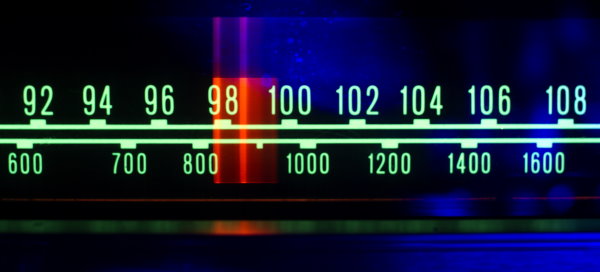
Frequency modulation combines a signal with a carrier wave by changing (modulating) the carrier wave’s frequency.
Starting with a cosine carrier wave with frequency fc Hz and adding a signal with amplitude β and frequency fm Hz results in the combination
The factor β is known as the modulation index.

We’d like to understand this signal in terms of cosines without any frequency modulation. It turns out the result is a set of cosines weighted by Bessel functions of β.
Component amplitudes
We will prove the equation above, but first we’ll discuss what it means for the amplitudes of the cosine components.
For small values of β, Bessel functions decay quickly, which means the first cosine component will be dominant. For larger values of β, the Bessel function values increase to a maximum then decay like one over the square root of the index. To see this we compare the coefficients for modulation index β = 0.5 and β = 5.0.
First, β = 0.5:

and now for β = 5.0:

For fixed β and large n we have
and so the sideband amplitudes eventually decay very quickly.
Update: See this post for what the equation above says about energy moving from the carrier to sidebands.
Proof
To prove the equation above, we need three basic trig identities
and three Bessel function identities
The Bessel function identities above can be found in Abramowitz and Stegun as equations 9.1.42, 9.1.43, and 9.1.5.
And now the proof. We start with
and apply the sum identity for cosines to get
Now let’s take the first term
and apply one of our Bessel identities to expand it to
which can be simplified to
where the sum runs over all even integers, positive and negative.
Now we do the same with the second half of the cosine sum. We expand
to
which simplifies to
where again the sum is over all (odd this time) integers. Combining the two halves gives our result
***
More on mathematics and radio.

You could also take a Hilbert transform of the signal compute the instantaneous frequency (d phase(y_analytic(t))/dt) and get right back at the 2*pi*f_c + beta sin(2 pi f_m t) ;)
Which seems a little specious, but Hilbert analysis (and the Hilbert-Huang Transform, https://cds.cern.ch/record/1115835?ln=no) is great for working with a non-stationary FM signal.
Nice article
However I would have written J2k(z) instead of Jk(z) in the first Bessel identity.
What would change if I want to take in acount the imaginary part of the frecuency modulation signal?
Excellent
Really great explanation, I think another way to examine this would be to use the Taylor series expansion of the sin in the argument, this may be a bit tedious but would better explain where the Bessel function multiplier comes from.